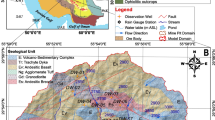Summary
Various theoretical approaches are used to model groundwater flow in fractured rock. This paper presents the application of several approaches to the restoration of the drainage of Rofla tunnel, Grisons, Switzerland. In this tunnel it became necessary to take measures against the washing out of calcium carbonates from the tunnel lining cement, because the calcium carbonate clogged up the existing drainage tubes leading to increased rock water pressures on the inside arch of the tunnel. Drainage boreholes were drilled on a section of the tunnel and their influence on the water pressures was monitored. On the basis of the geological survey different seepage flow models were established to reproduce the measured water pressures. The models were then used to predict the future water pressures acting on the tunnel lining after restoration. Thus, the efficacy of the different drainage proposals could be predicted and therefore optimised. Finally, the accuracy of the predictions is discussed and illustrated using the measurements in the test section.
Similar content being viewed by others
References
Aebli, H. R., Kobel, M. (1990): Kantonales Tiefbauamt Graubünden, Tunnelerneuerung Rofla: geologischer Bericht. Dr. M. Kobel und Partner AG, Büro für technische Geologie, Sargans.
Arn, Th. (1989): Numerische Erfassung der Strömungsvorgänge im geklüfteten Fels. Dissertation ETH Zürich, IBETH, Fels- und Untertagebau.
Arn, Th., Gmünder, Ch. (1991): AQUA-ROCK Benützeranleitung, Costra SA, Lugano.
Gmünder, Ch., Arn, Th. (1990): Roflatunnel Versuchsstrecke 89, Teil 1: 2-dimensionales Modell; Teil 2: 3-dimensionales Modell. Kantonales Tiefbauamt Graubünden.
Journel, A., Huijbregts, C. J. (1978): Mining geostatistics. Academic Press, London.
Kovari, K., Köppel, K. (1987): Head distribution monitoring with the sliding piezometer sytstem “Piezodex”. Field measurements in Geomechanics, Kobe, Japan.
Kovari, K., Arn, Th., Gmünder, Ch. (1989): Groundwater flow through fissures rock: field investigations and interpretation in the Albigna Dam area, Graubünden, Switzerland. NAGRA, NTB 90-10.
Long, J. (1983): Investigation of equivalent porous medium permeability in networks of discontinuous fractures. Ph. D. thesis, Berkeley, California.
Neuman, S. P. (1987): Stochastic continuum representation of fracture rock permeability as an alternative to the REV and fracture network concepts. 28th U.S. Symposium on Rock Mechanics, Tucson, Arizona.
Snow, D. T. (1965): A parallel plate model of fractured media. Ph. D. thesis, Berkeley, California.
Author information
Authors and Affiliations
Rights and permissions
About this article
Cite this article
Gmünder, C., Arn, T. Application of seepage flow models to a drainage project in fractured rock. Rock Mech Rock Engng 26, 113–135 (1993). https://doi.org/10.1007/BF01023619
Issue Date:
DOI: https://doi.org/10.1007/BF01023619




